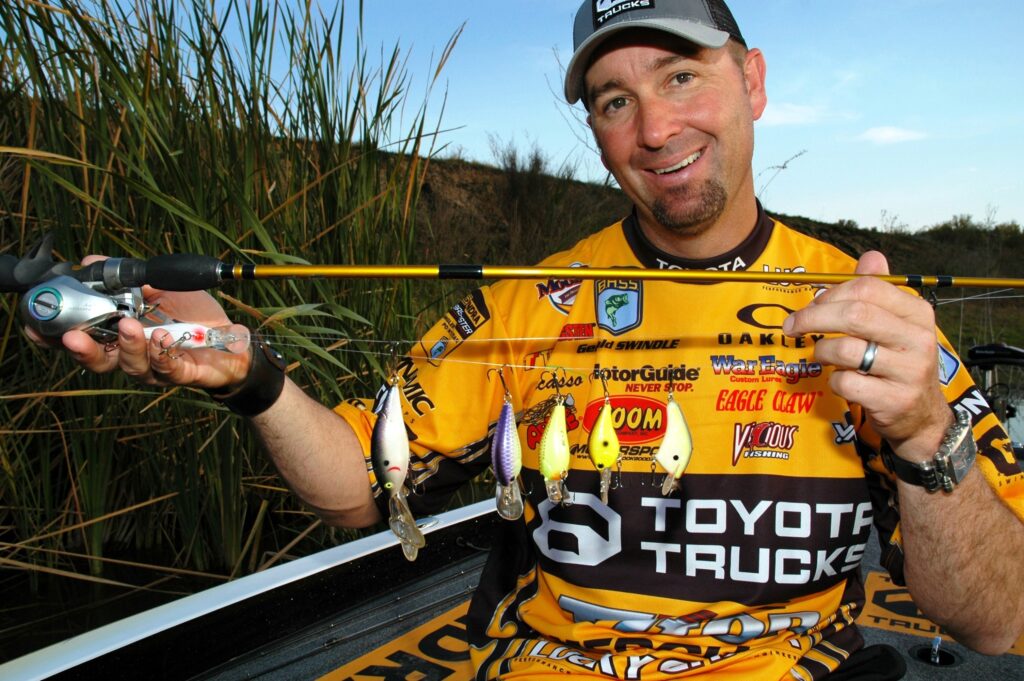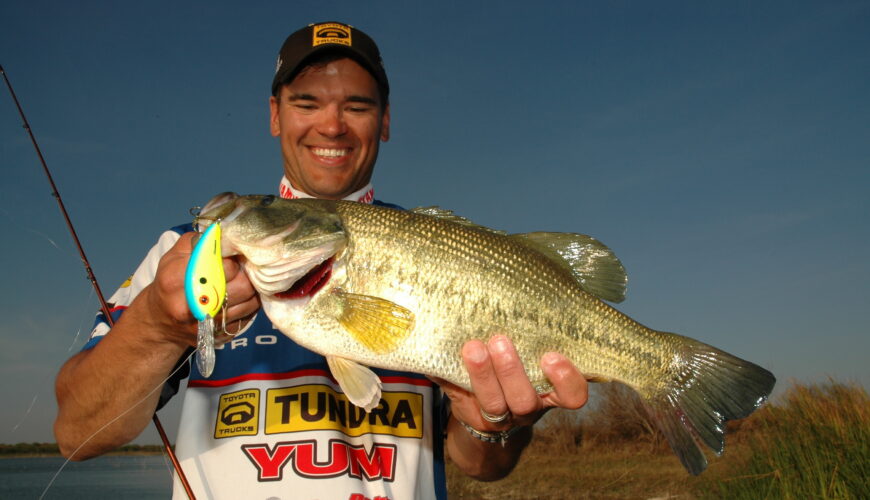Tactics
National Deer Association’s 5 Top Tips for Late-Season Deer Hunting
December 17, 2025 •iSportsman Staff
September 11, 2025
Most anglers simply cast out and reel in crankbaits. That works but put a little flair in the retrieve for more and bigger bass.
Crankbaits come in many sizes, shapes, colors and configurations. Short, rounded lures mimic bluegills and other sunfish. They wobble and run erratically. Long, thin baits imitate shad and create more subtle action. The longer and narrower the bill, the deeper the bait dives.
With broad lips, square-bill crankbaits make erratic movements with wider wobbles that give off tremendous vibrations, but don’t dive very deep. They work best around thick cover and in murky water. The squared bill helps the bait deflect off solid objects.
“A square-billed crankbait is one of my go-to baits,” advised Kevin VanDam, a four-time Bassmaster Classic champion from Michigan. “They are a mainstay for catching bass in shallow zones. The angled bills deflect off cover well. People fish them in laydowns, brush, rocks, gravel beds, grass and other cover. I use one all year long whenever the fish are up shallow. In the winter, bass move shallow in dirty water even in cold water.”

Crankbaits resemble baitfish, making them excellent lures to throw for largemouth bass like this one. John N. Felsher Photo
Bluegills spawn later than bass and might spawn throughout the warmer months. After bass finish spawning, they feed heavily upon bluegills and other sunfish. To imitate sunfish, throw short, fat, rounded square-billed crankbaits in firetiger, chartreuse, golds or browns with a splash of orange.
“When bass target bream, I throw crankbaits that looks like bream,” opined Gerald Swindle, an Alabama bass pro. “The body on most square-bills is rounder and short like a bluegill. In warm water, bream swim very erratically. The warmer the water, the more aggressive I want a bait to work. When I pull that lure out of shallow cover, I’ll put my rod down closer to the water to make the bait run a foot or so deeper to work that shelf effectively from the shoreline to the drop-off.”
With multiple protruding treble hooks, crankbaits would seem to snag every branch or stump. However, crankbaits can run through surprisingly thick stuff. The bills force baits to run nose-downward with the body shielding the hooks.
“People are amazed at how weedless crankbaits really are when fished properly,” advised Alton Jones, a former Bassmaster Classic champion from Texas. “I throw as close to cover as possible and fish very slowly to feel the lip hit the cover. Pause a second to let the lure float up. Walk it through cover by moving the bait with the rod instead of the reel. People get into trouble when they reel too fast or jerk a bait as it hits something.”
When hard plastic lips impact on logs or rocks, that sends vibrations reverberating through the water. Even if not feeding, any nearby bass might at least look to see what happened out of curiosity.
Usually, the lure bounces backward or pauses a moment. That pause could make hungry bass believe that a baitfish stunned itself, making it an easy, tempting prey. Then, the buoyant bait floats backward and upward out of the snag – most of the time! Let the bait float a little higher and retrieve it just over the snag.
When using a lure that runs a little deeper along the bottom, the lip digs into the muck and stirs up silt. This creates a mud trail that simulates a crawfish crawling on the bottom. Few hungry bass can resist a crawfish puttering around in the open! Occasionally pause the retrieve to let the bait float a foot or two off the bottom, making it more visible.
“I want baits that run just a little deeper than the bottom,” VanDam remarked. “For instance, if I’m fishing a ledge that’s 17 feet deep, I know that a Strike King 6XD can easily reach that depth. I want the bill to hit the bottom and deflect off any cover along the bottom.”
Matted weeds create the most imposing obstacles to crankbait fishing. Grass instantly fouls baits, so work lures around the edges and in seams. When fishing submerged aquatic weeds, run baits so they just tickle the grass tops. Sometimes, lunkers rise from their vegetative lairs to demolish what looks like passing baitfish, particularly one that appears wounded and struggling.
“I always like to just touch the grass tops when fishing crankbaits around submerged vegetation,” Swindle said. “I don’t want the bait to bury itself in the grass. For instance, if the water is five feet deep and the grass only comes two feet off the bottom, I throw a square-bill and rip it through the grass tops. When grass grows in deeper water, that’s when I throw a Rapala DT-6 or DT-10 with a rounder, smoother bill. When it hits the grass tops, I snap the rod almost like a small hookset to rip it up. That will clear the grass off the bill and I can go back to reeling it.”

Gerald Swindle, a professional bass angler from Guntersville, Ala., shows off some of his favorite crankbaits. Crankbaits come with many different types and shapes of lips. John N. Felsher Photo
Long-billed crankbaits work great for fishing long, sloping points and deep ledges. Run them parallel to the drops. Deep-running baits also entice bass suspended next to vertical structures such as standing timber, bulkheads and bridge or dock pilings. Suspended bass commonly move up and down in the water column, so anglers need to put baits slightly above the fish. When fishing docks, twist the line eye to make crankbaits run left or right. Some anglers keep two identical lures rigged, one that veers left and one to the right, so they hit each piling from different angles.
“I like to do a lot of deep cranking around bridge pilings for suspended fish,” VanDam stated. “I’ll throw different bait sizes to run at different depths until I find the right crankbait that gets to the right zone. During hotter times, many bass stay in deeper water. In the summer, I want to get the bait down quickly and reel it pretty fast to trigger reaction strikes. I don’t just run crankbaits in a straight line. I’ll give them a little jerk to make them move more erratically to trigger bass into biting.”
During temperature extremes, bass in deep water don’t want to chase baits very far or fast. Run deep-diving, flat-sided crankbaits much slower than more erratic square-bills. Pause the bait periodically so it hovers a few moments. Lethargic bass probably won’t go far to grab baits, but they might gulp down something tempting staring them in the face.
“Deep-diving crankbaits work for catching prespawn fish holding a little deeper in clear water,” VanDam commented. “When the water is cold, I want to get baits down deep quickly, but I slow the retrieve. If I’m not hitting bottom and getting a deflection, I do a lot of start and stop retrieves, especially when fishing clear water.”
Anglers throwing crankbaits in the right place at the right time might put many lunker largemouth in the boat quickly, particularly when bass feed heavily upon shad or other baitfish. That’s the time to get cranking!
 John N. Felsher is a professional writer, broadcaster, photographer, editor and consultant. An avid sportsman, he’s written more than 4,000 articles for more than 176 different magazines on a wide variety of outdoors topics. He also hosts an outdoors tips show for WAVH FM Talk 106.5 radio station in Mobile, Ala. Contact him at j.felsher@hotmail.com or through Facebook.
John N. Felsher is a professional writer, broadcaster, photographer, editor and consultant. An avid sportsman, he’s written more than 4,000 articles for more than 176 different magazines on a wide variety of outdoors topics. He also hosts an outdoors tips show for WAVH FM Talk 106.5 radio station in Mobile, Ala. Contact him at j.felsher@hotmail.com or through Facebook.
